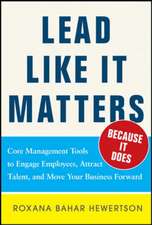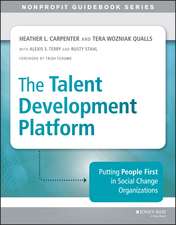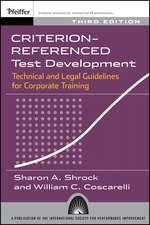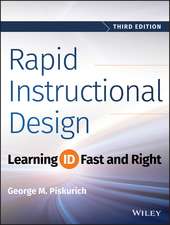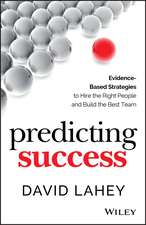Assessment Centers in Human Resource Management: Strategies for Prediction, Diagnosis, and Development: Applied Psychology Series
Autor George C. Thornton III, Deborah E. Ruppen Limba Engleză Hardback – 2 dec 2005
In addition, this book explores:
- assessment centers and human resource management;
- court cases involving assessment centers;
- innovations in assessment center operations;
- cross-cultural considerations including diversity of the workforce; and
- assessor training.
| Toate formatele și edițiile | Preț | Express |
|---|---|---|
| Paperback (1) | 463.34 lei 6-8 săpt. | |
| Taylor & Francis – 2 dec 2005 | 463.34 lei 6-8 săpt. | |
| Hardback (1) | 1123.68 lei 6-8 săpt. | |
| Taylor & Francis – 2 dec 2005 | 1123.68 lei 6-8 săpt. |
Din seria Applied Psychology Series
-
 Preț: 151.65 lei
Preț: 151.65 lei -
 Preț: 288.37 lei
Preț: 288.37 lei - 8%
 Preț: 543.04 lei
Preț: 543.04 lei - 9%
 Preț: 1073.61 lei
Preț: 1073.61 lei -
 Preț: 356.63 lei
Preț: 356.63 lei - 25%
 Preț: 1057.78 lei
Preț: 1057.78 lei - 16%
 Preț: 156.59 lei
Preț: 156.59 lei -
 Preț: 486.38 lei
Preț: 486.38 lei -
 Preț: 449.41 lei
Preț: 449.41 lei -
 Preț: 524.97 lei
Preț: 524.97 lei -
 Preț: 495.03 lei
Preț: 495.03 lei -
 Preț: 462.60 lei
Preț: 462.60 lei -
 Preț: 496.01 lei
Preț: 496.01 lei - 15%
 Preț: 545.79 lei
Preț: 545.79 lei -
 Preț: 449.41 lei
Preț: 449.41 lei -
 Preț: 392.93 lei
Preț: 392.93 lei - 18%
 Preț: 1001.84 lei
Preț: 1001.84 lei -
 Preț: 488.33 lei
Preț: 488.33 lei - 28%
 Preț: 823.91 lei
Preț: 823.91 lei -
 Preț: 448.49 lei
Preț: 448.49 lei - 15%
 Preț: 465.94 lei
Preț: 465.94 lei -
 Preț: 487.24 lei
Preț: 487.24 lei - 16%
 Preț: 249.24 lei
Preț: 249.24 lei - 18%
 Preț: 1120.23 lei
Preț: 1120.23 lei -
 Preț: 506.11 lei
Preț: 506.11 lei - 18%
 Preț: 1113.91 lei
Preț: 1113.91 lei -
 Preț: 143.43 lei
Preț: 143.43 lei - 15%
 Preț: 430.45 lei
Preț: 430.45 lei - 18%
 Preț: 1005.80 lei
Preț: 1005.80 lei -
 Preț: 491.60 lei
Preț: 491.60 lei -
 Preț: 449.41 lei
Preț: 449.41 lei - 18%
 Preț: 952.46 lei
Preț: 952.46 lei -
 Preț: 203.79 lei
Preț: 203.79 lei -
 Preț: 496.23 lei
Preț: 496.23 lei -
 Preț: 450.58 lei
Preț: 450.58 lei - 12%
 Preț: 318.90 lei
Preț: 318.90 lei - 12%
 Preț: 299.52 lei
Preț: 299.52 lei - 25%
 Preț: 1229.97 lei
Preț: 1229.97 lei - 28%
 Preț: 822.36 lei
Preț: 822.36 lei -
 Preț: 443.65 lei
Preț: 443.65 lei - 15%
 Preț: 461.03 lei
Preț: 461.03 lei
Preț: 1123.68 lei
Preț vechi: 1370.34 lei
-18% Nou
Puncte Express: 1686
Preț estimativ în valută:
215.01€ • 225.10$ • 177.91£
215.01€ • 225.10$ • 177.91£
Carte tipărită la comandă
Livrare economică 05-19 aprilie
Preluare comenzi: 021 569.72.76
Specificații
ISBN-13: 9780805851243
ISBN-10: 0805851240
Pagini: 382
Dimensiuni: 152 x 229 x 25 mm
Greutate: 0.87 kg
Ediția:1
Editura: Taylor & Francis
Colecția Psychology Press
Seria Applied Psychology Series
Locul publicării:Oxford, United Kingdom
ISBN-10: 0805851240
Pagini: 382
Dimensiuni: 152 x 229 x 25 mm
Greutate: 0.87 kg
Ediția:1
Editura: Taylor & Francis
Colecția Psychology Press
Seria Applied Psychology Series
Locul publicării:Oxford, United Kingdom
Public țintă
ProfessionalCuprins
Contents: J.N. Cleveland, E.A. Fleishman, Series Foreword. Preface. Assessment Centers in Human Resource Management. Case Studies of Assessment Centers in Operation. Basic Requirements of an Assessment Center. Taking a Closer Look at Developmental Assessment Centers. Behavioral Dimensions: The Building Blocks of Assessment Centers. Simulation Exercises. The Role of Individual Assessors: Observing, Recording, Classifying, and Scaling Behavior. The Role of the Group of Assessors: Integration of Assessment Information. Providing Feedback of Assessment Center Results. Varieties of Validity Evidence for Assessment Centers. Assessment Centers, Human Resource Management, and Organizational Strategies. Assessment Centers: A Look Back and a Look Forward. Appendices: Guidelines and Ethical Considerations for Assessment Center Operations. References to Employment Discrimination Cases Involving Assessment Centers.
Recenzii
"Thorton and Rupp's current work demonstrated that the application of assessment centers has broadened considerably from their initial application as a tool for selecting managers and leaders....especially thorough in documenting the successful broadening of assessment centers to DACs. It is hard not to appreciate the care and conscientiousness the authors give to their subject."
—PsycCRITIQUES
"This volume is an exceptionally clear, straightforward, yet thorough exposition of all the ins and outs of assessment center methods. It is meticulously grounded in wide ranging theory and research and very up-to-date....It brings together a host of information in a palatable way. It's an invaluable teaching and reference tool that professors, students, and practitioners will want to keep handy."
—Ann Howard
Development Dimensions International
—PsycCRITIQUES
"This volume is an exceptionally clear, straightforward, yet thorough exposition of all the ins and outs of assessment center methods. It is meticulously grounded in wide ranging theory and research and very up-to-date....It brings together a host of information in a palatable way. It's an invaluable teaching and reference tool that professors, students, and practitioners will want to keep handy."
—Ann Howard
Development Dimensions International
Notă biografică
Thornton III, George C.; Rupp, Deborah E.
Descriere
The theme permeating this book on assessment centers is "continuity and change", describing what has remained the same and what has changed in the 50-year history of the assessment center method. One of the important changes explored is the evolution of

